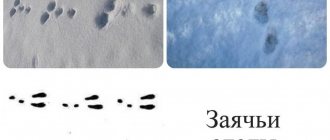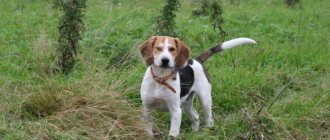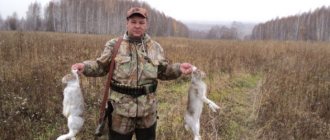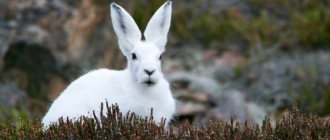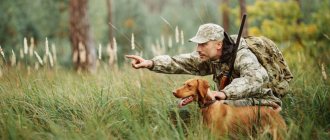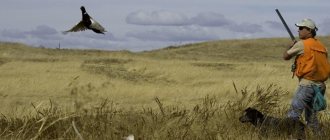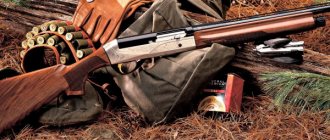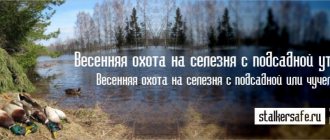What is the essence of hunting with hounds?
The main task of the hunters is to set the hounds on the hare and force it to leave its bed. Then, relying on the voices of the dogs, you should track the animal and be able to hit it with the first shot. There may simply not be a second chance! Hunting with hounds is a difficult task that requires endurance and observation: during the chase you can walk 10-15 kilometers, untangling the tracks of a meandering hare. Despite the excitement of the hunt, you should maintain concentration, because weather conditions are changeable and the hunted object is cunning.
Hare hunting is not an easy task , which has its own characteristics:
- The weather plays an important role. It is better to choose a cool day without rain, when it is easier to drive the hare out of its bed. In warm weather, it is impossible to do without loud noise and additional effort.
- In areas with tall grass, the task of searching for a hare in the thickets is assigned to the hunter, since it is difficult for hounds to get through the thickets.
- The hound needs time to prepare for the hunt, to search for the scent of the animal. As soon as the hare is raised from its bed, the dog must be directed and urged on, stimulating it with shouts and gestures to chase the hare.
- Most often, hunters reach an agreement that they do not shoot the hare immediately (as soon as they find it), but give the hounds the opportunity to drive it. This allows you to enjoy the hunting process.
Start of hunting season
You can start hunting with hounds in the fall, in mid-October. Sometimes this deadline is shifted by two weeks, to the beginning of November. The season closes before the first snow, in late November or early December.
Experienced hunters believe that setting a dog on a hare should be done according to the so-called. “black path”, on which there is no snow, and, accordingly, hare tracks. Otherwise, the dog will get used to ready-made tracks and will not be able to track the hare on the ground. If there is snow in places, then it is very difficult for the hound to track down its prey; it has to constantly adapt to changing conditions.
Beagle dog owners practice waking up early. The hunt takes place before dawn. This contributes to the successful search for hare tracks and beds. In order for a hare to get up from its rest, a loud noise is required. This is why hunting is a group event. After the hounds have picked up the scent, the hunter needs to take his position in anticipation of the hare.
Hunting dates
The season opens in late autumn. From late October to mid-winter. With such a duration of catching a hare, masters of chases with hounds prefer to divide the hunt into two periods: autumn catching on black-tropic ground and winter escape in deep snow.
Experience has repeatedly told them that the dog must definitely chase the prey during the snowless period, along the autumn paths, where there are no hare tracks left. This practice has a beneficial effect on maintaining the hunting skills of experienced dogs. He trains young people well. The target for prey is only by smell and instinct.
Masters are categorically against going hare hunting with young dogs in winter. There are many relaxing factors during this period for the hound spirit.
The shooters themselves study the habitat and bedding areas of the hare in advance. To set out in a group in the pre-dawn hour, before sunrise, and begin an enthusiastic escape for an animal from the wild.
What should a good hound be like?
The main sign of a good hound is its impeccable sense of smell. The scent glands of the hare are located on the pads of the paws. For this reason, it is very difficult to track down an immovable animal. When driving a hare from its resting place, the hound picks up the scent of the prey and pursues it. Endurance is no less important for a hound. Chasing prey for many hours requires a large supply of energy and strength.
At the same time, the hunter must understand that the dog is not his servant, but a partner, on whom he depends no less than on a person. Respect for your “colleague” makes the hunt productive. In essence, the hunter plays the role of a mentor who guides the hound along the right track.
What characteristics should a good hound have?
There are many requirements for a hound. A dog that is too fast, or, on the contrary, “on foot”, will not become a good assistant to the hunter, but will rather irritate and disrupt the entire dynamics of the process. The best option is the average rutting pace.
A good hound should be distinguished by its crawling ability, excellent scent, prey, viscosity, speed and perseverance. To improve these characteristics, training the hound is very important.
The hound's range is characterized by breadth - the dog should not constantly rub against its owner, it should explore all sorts of places, even at a sufficient distance from the hunter. However, at the same time, the dog should not lose track of its owner - a hound that disappears for several hours and starts a rut several kilometers from the hunters is of little use.
After raising the animal, the next important characteristic of the hound enters the race - good scent. The success of the entire hunt mainly depends on this indicator. Flair is important in order not to go around in the second and third circles and to recognize the more recent trail of the hare. A good sense of smell will allow the dog to recognize where and at what angle the prey turned, and where the hare got lost and chipped in, trying to deceive its pursuer. A dog’s good sense of smell is especially important in winter, when the trail of the pursued prey is not so clear. You can see how a hound follows the trail of a hare in the video.
The skill of the hound dog is also important for the successful outcome of the hunt. Only an experienced and mature hound can be able to catch a lost trail, recognize places where a fugitive could lie down and not lose the tempo of the rut. That is why constant training and coaching of hunting dogs is necessary. You can see how a hound is trained on a hare in this video.
The next important characteristic is viscosity, which means stubbornness in pursuit and reluctance to abandon prey. This feature is also important to develop for raising a good hound dog.
The pace and beauty of a real hare hunt will be lost without the agility of a dog. The paratha hound will pursue the animal at a closer distance and by the fresh and strong smell; during a fast race, the hare simply will not have time to do a bunch of tricks to throw off the pursuer. However, you need to be careful with a fast dog; it is important that, despite all its speed, it has excellent sense of smell, otherwise it may simply lose track or go back to its old ways.
An equally important characteristic for a hunter is the hound’s voice. By the different specifics of the voice, you can understand which animal the hound is walking by and at what stage the rut is currently underway. A dog’s good voice is a natural quality, which is why hounds with clear, speaking voices are especially valued. You can hear the barking of hounds and appreciate the beauty of the hare rutting with these dogs right now by watching the video.
How to train a hound to chase a hare?
Dog training should be done regularly throughout the year. Tasks that are different from each other guarantee better results. Particular attention should be paid to the physical training of the hound - running loads and preparing the paws for the forest (the hardened pads on the dog’s toes will ensure safety when moving over rough terrain). One option for training a hound to run at a stable, but not maximum, pace is to walk next to its owner riding a bicycle. The faster the dog chases the hare, the faster it will run away. At a low pace of the chase, the hare will periodically stop, which will make it easier for the hunter to aim and shoot.
Chasing a hare
Dogs begin preparing for hunting at the age of ten months. The preferred period is spring, since during this period the breeding of hares begins, forest and field paths are covered with odorous secretions. Training should start early in the morning. It should be remembered that in spring and summer, dogs are prohibited in hunting zones. The exception is areas prepared for this.
In the fall, training is also necessary for those dogs that have already been trained and participated in hunting before. During the first hunt, young hounds can be allowed to catch up and fight the hare a little. But under no circumstances should you be allowed to eat it ! You can reward your dog with a “pazanka” - a hare’s foot cut off from the prey. This should be done after each successful run.
Features of hunting with hounds for the white hare.
The white hare lives in the forest and rarely goes out into the open. And he will also run away from the hound through the forest. As a rule, the white hare does not prefer a continuous forest, but one where there are clearings, clearings and burnt areas. An adult hare “cuts” fairly even circles, while its brood runs along a more ragged trajectory, thereby confusing the hound. To escape from a dog, a white hare will seek shelter under a mountain, but not in a deciduous forest, where rustling leaves will give it away. Sometimes he breaks away from the correct circle if he sees danger. He turns to the side and, after making a couple of circles, returns to his place of rest. This is where the ambush should be set up.
To make the hunt successful
A successful hunt is the result of close interaction between hunter and hound. What is needed for this? Not so much:
- Start hunting in the immediate vicinity of the hare's bed. A few circles and loops - and the hare rushes back. That's where you should wait for him.
- When choosing clothes, consider the color of the environment. The hunter should not stand out against the background of the landscape.
- All movements should be confident, but unhurried. The hare does not pay attention to static objects. Therefore, waiting near the bed in a motionless stance can lead to the hare itself bumping into you, suspecting nothing.
- When setting up an ambush, take into account the direction of the wind. Do not stand in the wind; let the hare run out from the leeward side.
- Make sure the area is clearly visible. You should not be disturbed by grass, bushes, trees, hills, ravines, boulders.
- If you smoke, give up cigarettes while hunting. Tobacco smoke will give you away to the hare.
- Carefully study the lifestyle and habits of hares. Remember that the hare and the hare prefer different living conditions.
How to protect your hound from wolves?
Wolves are frequent guests of hunting grounds. This fact cannot be ignored, since you risk not only your own life, but also the health of your hunting partner - the hound. Wolves are not only dangerous predators, but also very smart animals. They understand perfectly well who their prey may be and do not hesitate to attack dogs in the presence of an armed hunter.
Minimizing the possibility of a wolf attack is quite simple. Hunters with significant experience are advised to stock up on spent cartridges. Before hunting, it must be hung on the hound's collar - the smell of gunpowder will scare away wolves. An alternative is a bell suspended from the hound's collar and accompanied by a rag that has been pulled through a gun barrel with traces of gunpowder. Like a shell casing, the rag will repel wolves with its scent. With these measures you can keep your hound safe and ensure a positive hare hunt outcome while enjoying the chase.
We hope that our tips will help you properly prepare for the hunting season and have a successful one.
Share
Hare hunting with a hound in late autumn
The white hare is brownish-gray in summer and snowy in winter; it lives in the forest, and when you look at it, you always remember the deep jungle, the smell of wet earth and fallen leaves. It always leaves the impression of some gloominess.
Not at all like a hare: his shaggy gray coat, which has absorbed the colors of ripe rye, autumn wormwood, and the lilac blackness of arable fields, pleases the eye with its cheerful diversity, and his grace, lightness and speed of running evoke the expanse of the steppe and fields where he lives all year round.
Hunting a hare with a hound has its own distinct charm and its own characteristic features.
- Hunting for hare provides much more opportunities to listen to the rut, enjoy its musicality, and requires the hunter to be more experienced and sharp in choosing a hole, that is, the ability to completely adapt to the terrain.
- The hunt for a hare usually takes place in a field, here and there interspersed with copses, and therefore the rut, weakened by the wind, now and then falls silent and gets lost, and the hunter is guided here not so much by ear as by eye, seeing the hare very far away and noticing his often surprising habits.
Each hunter has his own inclinations and attachments, his own mature love for this or that type of hunting, and it would be useless to argue about these attachments and tastes, as well as about tastes in general.
It is very good, of course, to wander in a deep forest in late autumn, on a soft and damp day, waiting for the hound to give a calling voice, but it is no less good to make your way - on the same day - through an open field, abruptly trumpeting a dog darting through the amber stubble or rustling fallen leaves in a bare and sparse forest.
Any hunt with hounds is very diverse: in a deep autumn forest, if the dogs are silent, you can whistle for a hazel grouse or hit a flying sage; a flock of fattened partridges may escape into the field, or a mallard drake may emerge mightily from the faded reeds.
The forest gives a feeling of peace and quiet, brings bright thoughts about swans on a hidden lake; the field reveals an immense expanse, torments the eyes with the blue distance, and the soul with the sacred poetry of wanderings.
I will never, never forget the days of late autumn in my native Russian field - these light-cold, as if starched clouds, these villages, homely, winter-like, wrapped in fawn straw, these winter fields, as if embodying the dream and memory of spring, this ancient a postal route along which sometimes three horses with crimson bells thundered.
A strong and sharp wind blew from the north, the stubble rang under my feet, in the copses, where I looked closely at every bush, there was a spicy smell of juniper, and every now and then a dog appeared in the distance - a tireless catch - the harlequin Budishka.
I often raised the hunting horn to my lips, sent a drawn-out, pleading call to the dog - and I walked and walked, with pleasure feeling the lightness of my gait, the coldness of the wind on my face, and the thirst for the rut that permeated my entire being.
Finally - Budishka’s desperate sobs were heard in the copse - a passionate, hot race began and began to weaken and move away.
Having emerged from the copse, I saw, very far away, a hare: it seemed to be flying through the stubble, resembling either a large moth or a stream. The dog, moving away before our eyes, growing away from him, also became smaller and smaller, turning, as it were, into a wind-up toy.
The rut soon became barely audible: the hare was making a huge circle, heading towards the distant Kasimovsky forest, which was slightly green beyond the field. Then the rut began to be heard again: first like a thin bell, then like a silent trumpet, more and more raising its triumphant passionate voice.
I looked through the binoculars: a pea appeared in its glasses, which suddenly turned out to be a small and nimble animal, magically growing into a seasoned hare. He rolled along the edge of the arable land, along a dry path, heading towards me, but suddenly he gave a dashing streak and, bending down, arching his back high, began to frequent the winter, turning completely blue.
The binoculars showed me how the hound stopped short at the very place where the hare had thrown off, how it, having lost its grip, silently rushed around in search of a trace. At this time, the hare paused, looked around, carefully rose to his hind legs, tucking his front paws to his chest, and suddenly rushed furiously, again making a desperate jump: Budishka, catching the trail, again choked in sobs.
Competing with the hare in speed, I rushed to the copse with all my youthful unbridledness and made it in time: the hare, rushing to the bed, ended up being shot, stretched out on the arable land in all its wild beauty. The hare and hound hunt is over.
I tied his paws with a belt, threw the expensive prey behind my back, waited for the dog and only then noticed how during the rut everything changed: the sky cleared, bloomed with cornflower blue purity, the wind freshened, the distances filled with such transparency that it seemed as if one could see not only the surrounding villages and villages, but also distant, unknown cities...
The day was already getting a little lighter, the sun was moving to the west, and I, again blowing the trumpet to Budishka, began to turn towards the Levashevsky forest, behind which was my hometown, my father’s house, waiting for me on a long and cozy evening with books, the wondrous shine of the Pleiades in the window, above the night a garden frozen from frost.
The hare noticeably pulled back his shoulder, but this heaviness invigorated and inspired, filling the young life with genuine hunting happiness.
